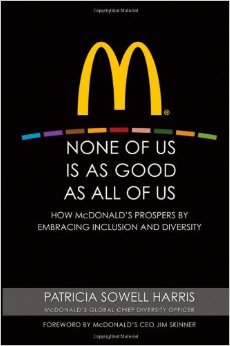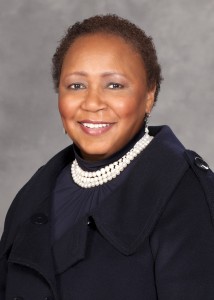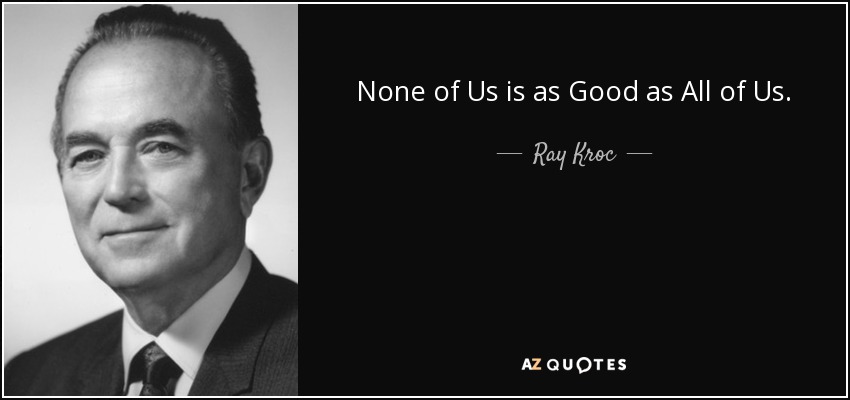Click here to return to Blog Post Intro

In None of Us is As Good as All of Us: How McDonald’s prospers by embracing inclusion and diversity, Patricia Sowell Harris points out that “Inclusion and diversity are not a destination you reach, they are a journey you take. There might be many milestones you pass along the way to mark your progress, but the real benefits come from a constant effort to do things better tomorrow than you do them today. You might achieve diversity goals from a numbers standpoint but still miss the mark, because the true measurement of your success is how you leverage diversity for the benefit of your business and your people.” That’s the essence of maximizing teamwork for an organization.
McDonald’s definition of diversity includes a broad mix of different ideas, opinions, backgrounds, and life experiences in addition to the traditional measures like race and gender. That’s how diversity is an active, living part of McDonald’s business strategies.
As you increase the critical mass of diversity within your own ranks, you build a broader and deeper pool of talent to draw from in building your management team. No single group of people has a monopoly on good leadership and bright minds, so the wider you cast your net, the more people with great potential you are likely to attract to your organization.
In the 1960’s, McDonald’s recognized they needed to change the complexion of the company to survive in a society that was dramatically changing all around them. If they were to continue to grow and expand, they needed to recognize the new realities of the world in which they operated and change their approach. They initiated a Fast Track program, called Accelerated Management Development, in which McDonald’s would recruit and hire promising African American prospects and advance them through the ranks.
In many cases, hiring and advancement of African Americans was less a racial challenge and more a corporate culture challenge. African Americans looked at certain practices as things that they had to subjugate themselves to, and when they refused, that increased their turnover rate. But what they weren’t understanding was that there were things that everybody had to do, and this was a cultural difference in how you take things, so they initiated the “Big Brother” program. Middle managers throughout the United States—all in the urban centers—pulled together to reverse the exodus of black talent. The program launched with a two-day symposium in Atlanta in 1977 and it soon developed into a very effective business mentoring program. The mentors in middle management made themselves available to promising assistant restaurant managers and helped them learn how the system worked, how to overcome obstacles, and how to achieve their career goals within McDonald’s.

At the same time, McDonald’s starting holding people accountable for diversity and began looking at the numbers.
The Black Employee Network also helped employees make personal adjustments to working in a very large organization. The network was key to connect black professionals in McDonald’s from different areas and provided an uncensored way of communicating. There were goals and objectives in those networks that were designed to help employees and help the issues of diversity overall.
Harris is quick to point out, however, that “Work Is Never Done: Creating a diverse workforce is a process that’s never finished, and we know that we have to work at it each and every day. She went on to explain that’s why she used Ray Kroc’s quotation as the title of this book: “None of us is as good as all of us.””
It’s clear that diversity takes more than good intentions and recruitment of minorities to be successful. You have to make sure that you provide the training and education that people need so they have the tools and understanding to be successful after they’ve won the job. And you also need to help your existing managers understand how they need to change and adapt their practices to assure that you tap all the diverse talent that you’re bringing into the organization.
Harris noted, “People began to understand that there’s white male culture, there’s Hispanic culture, there’s African American culture. It isn’t just that people are black or brown; they have a culture behind them. That was a major turning point into understanding people’s different cultures.”
She goes on to say, “Today, diversity is part of the McDonald’s fabric, and I see that continuing because we have so much talent in the pipeline. Even if we wanted to, we could not stop the advancement of diversity that McDonald’s has supported for so many years. One of the discoveries that has worked for McDonald’s that I would recommend to those of you who are managing diversity within your organizations is making sure that your own department reflects the groups you are serving.”
When asked if McDonald’s still requires a Diversity & Inclusion organization, Harris responds, “When diversity simply becomes part of McDonald’s culture—when everybody feels welcome and included and respected as partners within the business enterprise as a matter of course, when diversity becomes part of the very fabric of McDonald’s—that’s when the company will no longer need a separate department for inclusion and diversity.”
She continues, “To put it another way, diversity within your organization is not a destination you will ever reach; it is a journey you decide to take. While it is important to establish milestones, you should be making a conscious decision to create a culture that embraces diversity every day, all the time. The key lesson is that diversity is not something you do—it’s who you are.”
In summary, Harris (pictured below) says, “If we have learned anything through our experiences, it is that instilling the principles of diversity and inclusion takes patience and persistence. I am confident that our model of leadership support, training and education, and networks will be able to spark the seeds of opportunity to benefit our people and our business everywhere we operate.”

Management support, training and education, and networks are the three building blocks for an effective diversity initiative in any company.
May you adopt some of these best practices within your own team or organization, as you seek to maximize contributions from all of your team members, who shoot for the stars!


